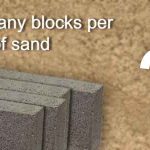Breeze blocks are a very common building material in homes throughout the UK. Most cavity walls are constructed with an internal skin of breeze blocks. This is mainly because the internal skin is not seen, and breeze blocks are a relatively strong and affordable product.
As a result, there are many occasions when you might need to drill into breeze blocks. The blocks themselves are quite easy to work with. Modern breeze blocks are made from a lightweight clay aggregate and are generally quite easy to drill into.

In older blocks, the materials used included coal ash, and cement. These are generally lower quality and don’t meet current building regulations for new builds. With that said, they are pretty standard in older properties, so there is a good chance you will be drilling into them, especially if your home isn’t reasonably new.
Whether you are drilling into old or new breeze block, the process is the same. The only difference, is older blocks tend to have a less consistent density, and you may sometimes find the blocks crumble when drilling.
New blocks will usually give a smoother drilling experience.
How to drill breeze blocks
Drilling into a breeze block is quite simple. This can be done with either a cordless drill/driver (this will need a hammer setting), or a hammer drill, such as an SDS.
If your cordless drill has a hammer setting, you will be able to see it on the torque control area. This is usually just behind the chuck of the drill. This will usually be marked with a drill and hammer on either side and a series of numbered settings.
The numbers are for controlling the torque. These settings are designed for screwing and drilling into different surfaces. For example, sometimes you will want to adjust this, based on different levels of resistance. It can also come in handy when you need to control things like screw depth.
To drill into masonry such as breeze blocks, you will simply need this turned around to the hammer setting.
If you do have an SDS drill, this is even better. Mainly because drilling is its primary purpose, and it will be more powerful than a cordless battery drill.
Choosing the right drill bit, screws, and plugs
Once you have decided on the tool you will be using, you will also need to use the correct drill bit.
For most smaller jobs around the house, such as fitting shelves, attaching skirting boards, or fitting a TV bracket, you will be using either red or brown plugs, and generally you will be using screws with a diameter of 8-10mm.
Red plugs take an 8mm screw, but they can also take a 10mm screw if you want to achieve an even tighter fixing.
Brown plugs are used for 10-12mm screws.
Generally, in the construction industry, a red plug is more commonly used by electricians. The are used for attaching things like backboxes and other light weight electrical fittings.
Brown plugs are more commonly used by other trades, such as carpenters, who are often fixing into solid surfaces, but need a slightly larger fixing. For example:
- Fitting door casings
- Skirting boards
- Attaching studwork to solid surfaces
- Etc
For most jobs around the house, either style plug will give you a strong and solid fixing.
Personally, I would usually use red plugs for shorter fixings, and brown plugs for anything over 3 inch (75mm).
For red plugs, you will need a 6mm drill bit and for brown plugs you will need an 8mm drill bit.
I am actually a fan of using a 7.5mm bit in blockwork with brown plugs. I find this gives a slightly tighter fitting. Which can be particularly helpful in older, more crumbly blocks.
The type of masonry bit you use, will depend on the type of drill you are using.
For a cordless drill, you will need some standard masonry drill bits. These are bits that can be tightened in your cordless drills chuck.
You can see a good example of some quality, affordable masonry bits from DeWalt by clicking here. As you can see, you get a selection of sizes. This includes a 6mm bit for red plugs and an 8mm bit for brown plugs.
If on the other hand, you are using an SDS drill, you will need a specific type of drill bit. Again, you can see a good example of a 10pc set from DeWalt by clicking here
Obviously, you don’t have to buy these exact drill bits. These are just ones I have personally bought in the past, and I found them to be good quality.
Pro tips
Sometimes you will find that the breeze blocks are a little crumbly and difficult to get a fixing. If this happens, you can try a couple of things to try and get a better fixing. Some of my favourites include:
- Pilot drill the hole with a smaller drill bit. This can be handy in older blocks and will reduce the risk of your hole being too big. Simply drill the hole once with a smaller bit, such as a 4mm bit, and then drill it again with the correct size.
- Drill a slightly tighter hole. I mentioned this previously, I particularly like using a 7.5mm bit for brown plugs. This would usually be 8mm. However, that extra 0.5mm can sometimes make all the difference.
Conclusion
Drilling into breeze blocks is pretty simple. All you need in order to do a good job, is a drill that is designed with a hammer setting. As well as the correct type of masonry bits. This will be a different type of bit for a cordless drill, or for an SDS drill.
If you have the right equipment, then drilling into a breeze block is quite easy. It is really no more difficult than drilling into any other surface.




